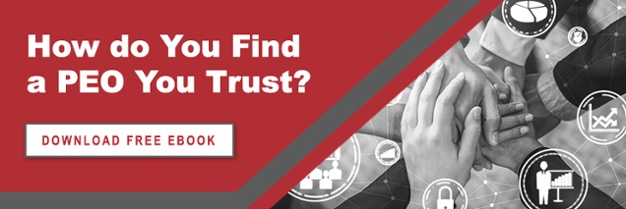
Around 175,000 businesses leverage the services of Professional Employer Organizations (PEOs) to help them navigate the human resources. That shouldn't be surprising. Around half of business owners spend over a quarter of their time dealing with HR issues, and the majority spend at least 18 hours a week dealing with HR administration. With the majority of business owners working over 40 hours a week, this HR time spend can become the difference between growth and energy-sapping headaches that clog your week with routine noise.
Not only do PEOs help small business owners shed their HR administrative responsibilities, but they provide an average ROI of 27.2%, help businesses experience a 10 - 14% lower turnover, and help business owners grow their businesses 40% faster.
But there's always a catch, right? Can you afford one? After all, that's a lot of benefits, so it must cost a fortune, right?
Here's the truth: almost every business can afford a PEO as long as they choose the right one. One major factor in the affordability of a PEO is their pricing structure.
How Are PEOs Priced?
Every PEO has its own pricing structure. For example, a local PEO may charge a flat fee per month or a flat fee per employee per month. On the other hand, a massive national PEO may charge a variety of pricing structures (e.g., percentage of payroll plus flat fees).
Traditionally, there are four primary pricing structures that PEOs leverage:
- Percentage of Payroll: These percentages can range anywhere from 1% to 12% of payroll. This model directly ties employee compensation to PEO costs.
- Flat Fee Per-Employee Per-Month: These costs can range from $40 to $200. You can pay employees weekly, bi-weekly, or monthly, and employee compensation isn't tied directly to your PEO costs.
- Flat Fee Per-Employee Per-Check: These costs can range from $25 to $150. Similar to per employee per month charges, per employee per paycheck doesn't tie costs to payroll, but it does tie costs to check frequency.
- Flat Fee Per Month: This is, by far, the simplest charge. You know exactly how much you're paying per month, regardless of headcount, salary, or paycheck frequency.
Each of these charges have their pros and cons.
Percentage of payroll is the most scalable and great for businesses that have part-time workers or seasonal employees. It also makes the most sense for growing businesses. Best-in-class PEOs offer discounts for bonuses, highly-paid executives, and business owners.
Flat fee per-employee per-month or per-check can become a problem for businesses that have part-time or seasonal employees. Under these models, part-time or seasonal employees cost as much as full-time employees.
Flat fee per month makes the most sense if your payroll is static, turnover is minimal, and your business isn’t growing.
What Factors Impact PEO Prices?
There are a few nuances that could impact your PEO prices, like:
- Your SUTA rates: In most states, when you join a PEO, they take over your SUTA responsibilities. If you have high SUTA rates due to employee turnover and unemployment claims, that can impact your PEO negatively. So, you may see additional costs based on your SUTA rates. The good news is: most states allow PEOs to file client SUTA into its own account. That means your PEO can help you reduce these rates, which earns you a net positive.
- Payroll-as-a-ratio: If you're working with a PEO that charges based on a percentage of payroll, your payroll-as-a-ratio of employees (i.e., having higher salaried employees) becomes important. Luckily, when you choose the right PEO, you get discounts for bonuses and higher-salaried executives.
- Gross payroll: Depending on your PEOs price structure, gross payroll may impact your costs. As mentioned, discounts are available for bonuses and highly-paid executives.
How Do PEOs Reduce Costs?
1. Access More Affordable Benefits
Small and mid-size business owners pay significantly more for benefits than enterprises. This is due to "risk pooling." The more employees you have, the less risky it is for your benefits providers to offer you benefits; the higher costs of unhealthy individuals are offset by the lower costs of healthy individuals.
PEOs bring enterprise-grade benefits to your business at low costs. PEOs can bring employees from all the businesses they partner with to the benefits negotiating table. This allows them to secure better benefits due to economies-of-scale.
An added benefit is that clients get to use the PEO’s online system (or benefits personnel) to onboard new employees and enroll into benefits. This saves clients time while staying compliant with all relevant HR laws and regulations.
2. Lower Employee Turnover
Did you know that companies partnered with PEOs experience 10 to 14 percent lower turnover? The combination of better benefits, more accurate payroll, and employee self-service options help businesses retain their critical talent. The cost-savings here are enormous. Not only does it cost over $4,000 to onboard a new employee and up to 2 years to get them fully productive, but lower turnover lowers your SUTA rates and helps you create a more cohesive company culture.
3. Workers’ Comp
Without a PEO, finding ideal workers’ compensation coverage for your industry takes both time and money. In most states, PEOs search across dozens of carriers for the best pricing and fit for your company.
Coverage that doesn't involve a PEO usually requires a deposit. Each year, businesses have to engage in a workers’ comp audit. PEOs both handle the deposit and the yearly audit.
Shifting administrative tasks such as finding workers’ comp coverage adds up to impressive savings. A study from NAPEO (National Association of Professional Employer Organizations) found that PEO clients save 21% on HR administration.
Can You Afford NOT To Hire A PEO?
Best-in-class, local PEOs provide a higher ROI than run-of-the-mill national PEOs. However, all PEOs provide a positive ROI. The ability to access Fortune 500 benefits at Fortune 500 prices can offset the cost of a PEO by itself. Once you consider workers' compensation, administrative reductions, and payroll, PEOs provide significant value to every business.
The question isn't, "can you afford a PEO?" It's how can you not? But how do you know which PEO to choose? Learn how to distinguish between best-in-class and average PEOs by downloading "How to Find the Best PEO for Your Business."

